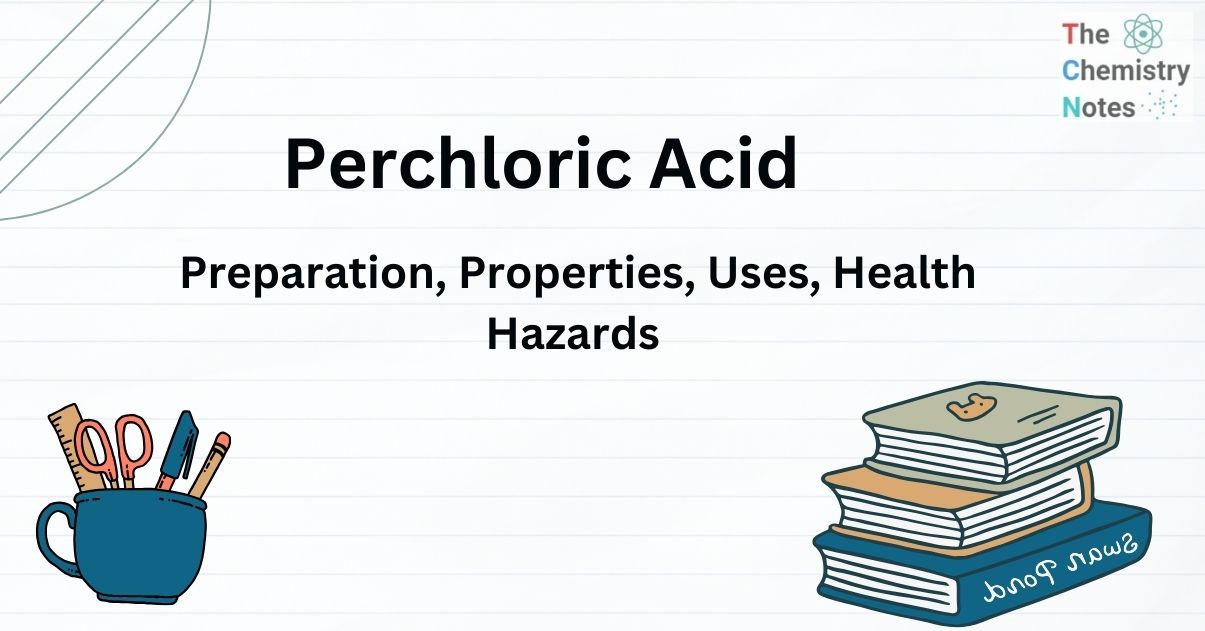
Perchloric acid is the chemical name for chlorine oxoacid. It is also known as hydroxidotrioxidochlorine or hyperchloric acid (HClO4). Acid is a transparent, colorless, and odorless aqueous solution with a concentration ranging from 50% to 72%. It corrodes metals and tissues. Closed containers can violently rupture when exposed to heat for an extended period.

HClO4 is a chemical that is similar to sulfuric acid in many ways. It is a strong acid with a high boiling point that is particularly stable in solution. It has several advantages over sulfuric acid, such as being monobasic and having a low concentration of insoluble ions.
It is a colorless, odorless, and oily corrosive inorganic liquid. It is miscible with water, has a boiling temperature of 203 OC, a melting point of 19 degrees Celsius, and a low vapor pressure of 6.8 mm Hg at 25 OC. A cool 70% aqueous perchloric acid solution is a strong acid or superacid (stronger than sulfuric and nitric acids), however, it is not always a strong oxidizing agent. However, when perchloric acid concentration and temperature rise, so does its oxidizing power.
Because perchloric acid is highly reactive, it must be stored apart from other chemicals, especially organic solvents, organic acids, and reducing agents. All Perchloric acid containers should be tested regularly for container integrity and discoloration. Perchloric acid that has become discolored should be disposed of as hazardous waste. Perchloric acid should be used and kept in an area away from combustible items and wooden furniture.
Preparation of Perchloric acid
Treating sodium perchlorate solution with hydrochloric acid (HCl) produces HClO4 by precipitating solid sodium chloride. The chemical equation for the same is given as follows:
NaClO4 + HCl → NaCl + HClO4
The reaction of NH4ClO4 and HNO3 also produces HClO4.
NH4ClO4 + HNO3 → HClO4 + NH4NO3
HClO4 is commercially available as 70% HClO4, Which has almost the composition of dihydrate HClO4. 2 H2O. It is only oxyacid of chlorine that can be isolated in anhydrous form. Its anhydrous form is made by dehydrating HClO4. 2 H2O with fuming sulphuric acid, other separating HClO4 by vacuum distillation.
Properties of Perchloric acid
- It is the strongest acid known.
- The anhydrous form is a powerful oxidizing agent that explodes on contact with organic materials (wool, paper, cloth, grease rubber, or chemicals) and sometimes on its own.
- Hot concentrated solutions have been used for wet ashing where all organic materials in the sample are oxidized to CO2, leaving only the inorganic constituents for analysis.
- On dehydration with P2O5, it gives Cl2O7.
2 HClO4 + P2O5 → Cl2O7 + 2 HPO3
Uses of Perchloric acid
- The primary application of HClO4 is as a precursor to ammonium perchlorate, an inorganic chemical that is an essential part of rocket fuel. As a result, perchloric acid is regarded as a more critical chemical molecule in the space industry.
- The same compound can also be utilized in the etching of Liquid Crystal Display (LCD) systems. As a result, HClO4 is now widely used in the electronics industry.
- HClO4 is used as an oxidizer in the separation of sodium and potassium.
- It is used in the manufacture of explosives.
- It is used for metal plating.
- It is employed as a reagent in the determination of 1H-Benzotriazole.
- It serves as a catalyst.
Health Hazards of perchloric acid
Inhaling the vapors of this specific molecule induces a burning sensation in the nose and throat, as well as lung irritation and coughing. When exposed to this substance over an extended period, it produces vomiting. This can induce burning and gastrointestinal burns if consumed. When heated, this chemical emits unpleasant, corrosive, and poisonous fumes.
HClO4 is regarded as a particularly potent oxidant. Because of its highly oxidizing characteristics, this molecule has extremely high reactivities towards the majority of metals. Furthermore, this chemical is extremely reactive to organic materials. This substance is corrosive to human skin. As a result, proper precautions should be taken when handling this combination.
Precautions to be taken while using perchloric acid
- HClO4 digestions and other high-temperature treatments must be carried out in specially built perchloric acid fume hoods.
- Never use an open flame or an oil bath to heat perchloric acid. It is preferable to use electric hot plates, electrically or steam-heated sand baths, heating mantles, or steam baths.
- Allowing heated HClO4 to come into touch with organic compounds is not recommended. Avoid using perchloric acid-incompatible greases.
- Do not distill HClO4 in a vacuum because an unstable anhydride may form, resulting in a spontaneous explosion.
- Vacuum pumps should be fully cleansed and refilled with Kel-F or Fluorolube before using perchloric acid.
- Following the operating instructions provided by the maker of the perchloric acid hood, wash down perchloric acid hoods after each usage.
References
- https://byjus.com/chemistry/perchloric-acid/.
- https://www.sciencedirect.com/topics/chemistry/perchloric-acid.
- https://www.vedantu.com/chemistry/perchloric-acid.
- https://safety.fsu.edu/safety_manual/supporting_docs/Perchloric%20Acid%20Safety.pdf
